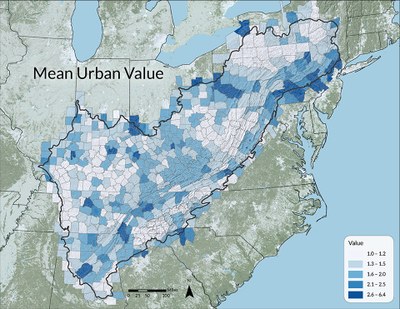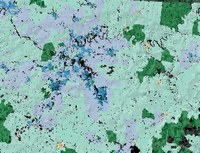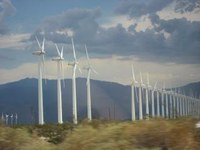Urbanization
 Urban and exurban development have been among the strongest drivers of landscape change in the Appalachian region as a whole. The conversion of land to these uses is projected to continue at a rapid pace.
Urban and exurban development have been among the strongest drivers of landscape change in the Appalachian region as a whole. The conversion of land to these uses is projected to continue at a rapid pace.
Water — Increases in urban land uses in landscapes with strongly varied topography and steep slopes are expected in the Appalachian-Cumberland region. Coupled with forest loss, this can exacerbate discharge rates, peak flow, and stream velocity. Increased impervious surface and forest loss associated with urbanization typically result in reduced surface water availability for human consumption, and can increase concentrations of stream sediments, nutrients, and pollutants.
Timber and nontimber forest products — Urbanization is expected to reduce the land area available to support working forests, and alter the dynamics of nontimber forest product harvest, fishing, and hunting in nearby forests. Absence of freshwater fish from degraded streams may represent significant loss of fishing expenditures.
Carbon storage — Forest loss associated with urbanization results directly in reduced carbon storage capacity. These losses, together with similar effects of surface mining, may outstrip regional gains from forest growth, without significant changes in urban development policy, restoration efforts, timber markets, and other factors.
Rural landscape values and outdoor recreation — The changes that come with urbanization and low-density development can have negative impacts on the unique sense of place and quality of life of rural Appalachian-Cumberland communities. Landscapes dominated by hardwoods and agriculture are likely to continue to be threatened by land-use changes associated with urbanization, in turn linked to income and population growth. As rural landscapes and water supplies are increasingly converted to more intensive uses, opportunities for outdoor recreation are expected to decline. At the same time, demand for such opportunities is expected to increase with the population growth that accompanies urban and exurban expansion, placing increased pressure on nearby accessible sites with limited capacity.
References
Bowker, J. M., and A. Askew. 2013. Outlook for outdoor recreation in the northern United States. A technical document supporting the Northern Forest Futures Project with projections through 2060. Gen. Tech. Rep. NRS-120. USDA Forest Service, Northern Research Station: 62 pp.
Coulston, J. W., D. N. Wear, and J. M. Vose. 2015. Complex forest dynamics indicate potential for slowing carbon accumulation in the southeastern United States. Scientific Reports 5: 8002.
Gardiner, E. P., A. B. Sutherland, R. J. Bixby, M. C. Scott, J. L. Meyer, G. S. Helfman, E. F. Benfield, C. M. Pringle, P. V. Bolstad, and D. N. Wear. 2009. Linking stream and landscape trajectories in the southern Appalachians. Environmental Monitoring and Assessment 156(1): 17-36.
Hanson, C., L. Yonavjak, C. Clarke, S. Minnemeyer, L. Boisrobert, A. Leach, and K. Schleeweis. 2010. Southern Forests For the Future. World Resources Institute, Washington, D.C.: 73 pp.
Hayden, L., S. Hendricks, M. Bowker, D. English, N. Stremple, and D. Bayless Ray. 1996. Outdoor recreation demand and supply in the region, Chapter 4, 139-176. In The Southern Appalachian Assessment Social/Cultural/Economic Technical Report. Report 4 of 5, USDA Forest Service, Southern Region: 208 pp.
Huggett, R., D. Wear, R. Li, J. Coulston, and S. Liu. 2013. Forecasts of forest conditions, Chapter 5, 73-101. In D. N. Wear and J. G. Greis, editors, The Southern Forest Futures Project: Technical Report. Gen. Tech. Rep. SRS-178, USDA Forest Service, Southern Research Station: 542 pp.
Jackson, L. E., B. Rashleigh, and M. E. McDonald. 2012. Economic value of stream degradation across the central Appalachians. Journal of Regional Analysis and Policy 42(3): 188-197.
Keyser, T., J. Malone, C. Cotton, and J. Lewis. 2014. Outlook for Appalachian-Cumberland forests: a subregional report from the Southern Forest Futures Project. General Technical Report SRS-GTR-188. USDA Forest Service, Southern Research Station: 83 pp.
Lockaby, G., C. Nagy, J. M. Vose, C. R. Ford, G. Sun, S. McNulty, P. Caldwell, E. Cohen, and J. Moore Myers. 2013. Forests and water, Chapter 13, 309-339. In D. N. Wear and J. G. Greis, editors, The Southern Forest Futures Project: Technical Report. Gen. Tech. Rep. SRS-178, USDA Forest Service, Southern Research Station: 542 pp.
Shifley, S. R., F. X. Aguilar, N. Song, S. I. Stewart, D. J. Nowak, D. D. Gormanson, W. K. Moser, S. Wormstead, and E. J. Greenfield. 2012. Forests of the Northern United States. Gen. Tech. Rep. NRS-90, USDA Forest Service, Northern Research Station: 202 pp.
U.S. Department of Agriculture Forest Service. 2012. Future of America's Forests and Rangelands: Forest Service 2010 Resources Planning Act Assessment. Gen. Tech. Rep. WO-87. USDA Forest Service: 198 pp.
U.S. Environmental Protection Agency. 2008. EPA's 2008 Report on the Environment. EPA/600/R-07/045F. National Center for Environmental Assessment, Washington, D.C.: 366 pp.
Wickham, J. D., and C. H. Flather. 2013. Integrating biodiversity and drinking water protection goals through geographic analysis. Diversity and Distributions 19(9): 1198-1207.
Wickham, J. D., R. V. O'Neill, K. H. Riitters, E. R. Smith, T. G. Wade, and K. B. Jones. 2002. Geographic targeting of increases in nutrient export due to future urbanization. Ecological Applications 12(1): 93-106.



![Hemlock Wooly Adelgid By Nicholas A. Tonelli from Pennsylvania, USA (Henry's Woods (6)) [CC BY 2.0 (http://creativecommons.org/licenses/by/2.0)], via Wikimedia Commons](https://workinglandsforwildlife.net/ecosystem-risks-benefits/risks/hemlock-wooly-adelgid/@@images/b0bf0bc4-1b53-4b20-8e38-e82d344bee8c.jpeg)

![Wildfires in Eastern U.S. By Glenn Research Center (https://www.dvidshub.net/image/857727) [Public domain], via Wikimedia Commons](https://workinglandsforwildlife.net/ecosystem-risks-benefits/risks/wildfires-in-eastern-u.s/@@images/0d2bbb65-9ef4-4070-a99f-c36b403f71cf.jpeg)
























